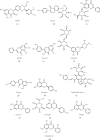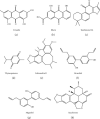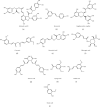A Comprehensive Review of Natural Products against Liver Fibrosis: Flavonoids, Quinones, Lignans, Phenols, and Acids
- PMID: 33082829
- PMCID: PMC7556091
- DOI: 10.1155/2020/7171498
A Comprehensive Review of Natural Products against Liver Fibrosis: Flavonoids, Quinones, Lignans, Phenols, and Acids
Abstract
Liver fibrosis resulting from continuous long-term hepatic damage represents a heavy burden worldwide. Liver fibrosis is recognized as a complicated pathogenic mechanism with extracellular matrix (ECM) accumulation and hepatic stellate cell (HSC) activation. A series of drugs demonstrate significant antifibrotic activity in vitro and in vivo. No specific agents with ideally clinical efficacy for liver fibrosis treatment have been developed. In this review, we summarized the antifibrotic effects and molecular mechanisms of 29 kinds of common natural products. The mechanism of these compounds is correlated with anti-inflammatory, antiapoptotic, and antifibrotic activities. Moreover, parenchymal hepatic cell survival, HSC deactivation, and ECM degradation by interfering with multiple targets and signaling pathways are also involved in the antifibrotic effects of these compounds. However, there remain two bottlenecks for clinical breakthroughs. The low bioavailability of natural products should be improved, and the combined application of two or more compounds should be investigated for more prominent pharmacological effects. In summary, exploration on natural products against liver fibrosis is becoming increasingly extensive. Therefore, natural products are potential resources for the development of agents to treat liver fibrosis.
Copyright © 2020 Xiaoqi Pan et al.
Conflict of interest statement
The authors declare that there are no conflicts of interest.
Figures




References
-
- Forouzanfar M. H., Alexander L. Global, regional, and national comparative risk assessment of 79 behavioural, environmental and occupational, and metabolic risks or clusters of risks in 188 countries, 1990–2013: a systematic analysis for the Global Burden of Disease Study 2013. The Lancet. 2015;386:2287–2323. doi: 10.1016/S0140-6736(15)00128-2. - DOI - PMC - PubMed
Publication types
LinkOut - more resources
Full Text Sources
Other Literature Sources

